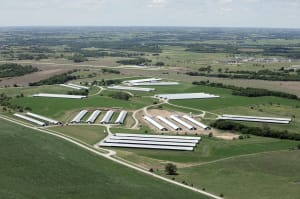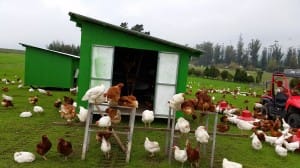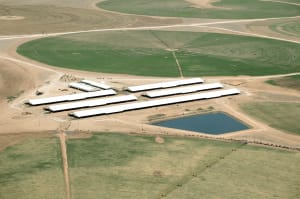Organic Industry Bigwigs Dispute What Cornucopia’s Aerial Photos Reveal
by Mark A. Kastel
Organics was founded on a loving collaboration between family farmers and eaters who established an alternative to the industrial paradigm of how our food, including livestock, is produced.
When we founded The Cornucopia Institute, nearly 11 years ago, there were two CAFOs (concentrated animal feeding operations or “factory farms”), each producing “organic” milk from thousands of cows. Today, there are over 20.
The Organic Foods Production Act, passed by Congress, is a good law but both the Bush and Obama administrations have rolled out the red carpet for corporate agribusiness lobbyists to shape organic regulations and enforcement with an emphasis on profit rather than organic integrity.
Over the past decade, Cornucopia has hammered the USDA and the White House on grossly incompetent, or intentionally harmful, management of the organic program. We have filed numerous legal complaints, some of which have shut down factory farms or constrained their production, while others have been ignored or dismissed.
So, throughout most of 2014, Cornucopia contracted with a professional aerial photography service to photograph 15 “certified organic” factory farms from West Texas to the eastern seaboard (view the photo gallery here).
We forwarded over 250 highly detailed 50-60 MB images to the USDA. We additionally provided scores of other satellite photos and supporting documentary material.
Our flyover campaign was the subject of an investigative report on December 11 in the Washington Post (so we know this landed on the USDA Secretary’s desk). And what have been the results?
The U.S. Department of Agriculture
Nothing. Congress charged the USDA with protecting the interests of ethical organic stakeholders and the authenticity of organic food. You’d think that the magnitude of the alleged violations would prompt some kind of response. We’re talking about dairies managing 18,000 cows and poultry “farms” licensed to raise over 1 million hens.
Weeks after we transferred this information to the USDA, they have said nothing publicly. They didn’t even acknowledge receipt of the voluminous materials we supplied, via Federal Express and email, until we contacted the National Organic Program Staff Director, Miles McEvoy. He subsequently had their enforcement staff confirm that they had, indeed, received the evidence.
Organic Trade Association
It’s a shame that the OTA, the powerful industry lobby group, would express no concern over the threat to organic integrity represented by the widespread pattern of giant industrial-scale livestock producers “gaming the system” and the USDA going along for the ride.
When the reputation of organics is tarnished, everyone loses, large and small industry participants alike, as well as organic eaters.
Instead, the OTA issued an industry damage-control release stating: “We continue to have confidence in the oversight of organic operations and in the checks and balances built into the organic certification system which includes regular inspections of operations, regular accreditation audits of certifiers, and complaint investigation procedures.”
Nate Lewis, a specialist on organic certification of livestock operations for the OTA, was unimpressed by the photos. “For any of these photos, I could come up with a completely valid reason for what you’re seeing,” he told an NPR reporter. In the case of egg-laying chickens, for instance, the rules allow animals to be enclosed for several different reasons, such as when temperatures outside are too hot or cold, for reasons of preventive health care, or when the chickens are very young.
Maybe Mr. Lewis’ title should be changed to “Corporate Apologist.” He certainly is doing his job defending OTA members.
But isn’t it a coincidence that all 14, randomly selected factory farms, producing “organic” eggs, milk and chicken, were confining their animals on a wholesale basis the day an airplane happened to fly overhead? Does this instill confidence, as the OTA has, in organic oversight of certification by the USDA? I will remind readers that, until recently, 100% of the inspections that took place, annually, were made by appointment. And now the certifiers, being paid by their clients, are choosing which outfits get unannounced visits.
Upton Sinclair once said, “It is difficult to get a man to understand something, when his salary depends on his not understanding it.”
Chino Valley (Idalou, Texas)
“Based on what I see in the picture, it’s high noon,” said David Will, general manager of an associated company, Chino Valley Ranchers. “You will find that birds avoid being outside on bright sunny days. They are a prey creature. They are not predators.” The day after the article appeared in the Washington Post, Chino sent the newspaper a photo of a small percentage of their birds outdoors.
The 15 high-resolution photographs Cornucopia shared with the USDA, shot from every angle, show no birds out (either in direct sunshine or in the shade). Four additional satellite images, from two other days, show no birds out as well.
What should the public and the USDA believe? Unannounced, independently procured photos or a possibly “staged” photo submitted by the factory farm operator under scrutiny?
Aurora Dairy (Clearwater, Texas)
“A single photo doesn’t really tell us anything about a farm and its practices,” an Aurora spokesperson, Sonja Tuitele, told the Washington Post. “Our records do indicate that all of our lactating cows at the Coldwater facility were grazing on pastures on May 17. Since we don’t know what time of day this photo was taken, we can only assume this photo was taken outside of their daily grazing hours.”
The shadows in the photo suggest it is about mid-day. Maybe if you are a highly paid executive at an industrial dairy concern, you might think of “grazing hours” the same way some country club members think about “banker’s hours.” Most real organic farmers don’t limit their cows’ access to pasture—and the law doesn’t allow for that (unless there are weather concerns). The photos were taken on a sunny 78-degree day, perfect grazing conditions for the 18,000 cows at Aurora’s Coldwater, Texas feedlot.
Organic Valley
Maybe the most disappointing response has come from George Siemon, CEO of Organic Valley, a farmer-owned cooperative that has grown to an almost $1 billion a year enterprise. In an interview on NPR, Siemon said that he does not believe that “the organic producers targeted by Cornucopia are flouting the rules.”
This might seem like a strange disconnect coming from the leader of a co-op that gets almost all of its milk and eggs from family-scale farmers. That is, until you dig a little deeper and find that, when it ran short of milk a few years ago, the management of the co-op (without the knowledge of its farmer-owners) decided to purchase milk from one of the targeted factory farm dairies: Natural Prairie in Texas, milking 8,500 cows. This continued until OV farmers demanded it stop.
Evidently management didn’t learn much from the experience because when they wanted “local” California eggs, they chose an industrial/confinement operation, Petaluma Farms, currently under investigation for organic violations and animal abuse, after settling a lawsuit for consumer fraud. You won’t find the name “Petaluma Farms” on the OV website. They refer to their new “family farm” member in California as “Judy and Steve’s Egg Farm,” delineating the first names of the agribusiness’ owners.
Closing Thoughts
In the pages of his best-selling The Omnivore’s Dilemma, Michael Pollan describes Petaluma Farms as a good representation of his definition of “supermarket pastoral.” I call this type of subterfuge “farming by press release.”
As they say, a picture is worth a thousand words. Either these corporate executives and lobbyists are in need of a good ophthalmologist or their definition of organics differs from the farmer-members at The Cornucopia Institute and our urban-allies, who believe in the environmental stewardship, humane animal husbandry, and positive health and social impacts that true organics represents.
This story originally appeared in the spring issue of The Cultivator, The Cornucopia Institute’s quarterly print publication available to members and online.
Cornucopia’s scorecards rating hundreds of brands of organic dairy, eggs, soy foods, breakfast cereal and yogurt help you choose the best foods while rewarding the true organic heroes.




